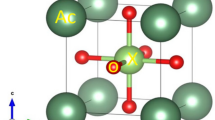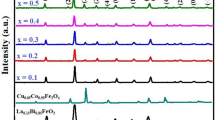Abstract
Conductivity data of (AgI)(1−x)–(Al2O3)x nanocomposites are fitted by using a random variable theory with a probability density in the charge carriers. Experimental data show that the increase in alumina concentration leads to a decrease in the jump in conductivity experienced by the system at 420 K. The experimental data, both the abrupt jump and the logarithm of conductivity times temperature as a function of the inverse of temperature behavior in the 300–500 K temperature range and concentrations x = 0.0,0.3,0.6, and 0.8 per mol, were well fitted. The abrupt change in conductivity results from the sudden increase in the number of carriers with a probability distribution function that varies with the reduced temperature of the system. The chosen values for the parameters Γ and χ that fit the conductivity behavior for each concentration are on the theoretical curve predicted by the model with a probability density in the charge carriers.




Similar content being viewed by others
References
Habasaki J, Leon C, Ngai KL (2017) Dynamics of glassy, crystalline and liquid ionic conductors. Springer, New York
Kamal KK (2017) Composite materials. Springer-Verlag, New York
Brownlee BJ, Tsui L-K, Vempati K, Plumley JB, Iverson BD, Peng TL, Garzon FH (2020) J Appl Phys 128:035103. (pp 8)
Nagai M, Nishino T (1992) Sol Stat Ionics 53-56:63–67
Lee JS, Adams S, Maier J (2000) J Electrochem Soc 177:2407–2418
Takahashi T (1989) (ed) High conductivity solid ionic conductors: recent trends and applications. World Scientific Publishing Co, Singapore
Liu LF, Lee SW, Li JB, Alexe M, Rao GH, Zhou WY, Lee JJ, Lee W, Gösele U. (2008) Nanotechnology 19:495706 (7 pp)
Mirabal N, Aguirre P, Santa Ana MA, Benavente E, Gonzáles G (2003) Electrochem Acta 48:2123–2127
Uvarov NF, Isupov VP, Sharma V, Shukla AK (1992) Sol Stat Ionics 51:41–52
Shastry MCR, Rao KJ (1992) Sol Stat Ionics 51:311–316
Agrawal RC, Gupta RK (1999) J Mat Sci 34:1131–1162
Aniya M (2019) Pure Appl Chem 91:1797–1806
Rains CA, Ray JR, Vashishta P (1993) Computer simulation studies in condensed-matter physics IV. Springer, New York
Shahi K, Wagner JB (1982) J Sol Stat Chem 42:107–119
Knauth PL (2000) Electroceram 5(2):111–125
Jow T, Wagner Jr JB (1979) J Electrochem Soc 126(3):1963–1972
Maier J (1995) Prog. Solid State Chem 23:171–263
Uvarov NF, Ponomareva VG, Lavrova GV (2010) Russ J Electrch 46:772–784
Uvarov NF, Hairetdinov EF, Bokhonov BB, Bratel NB (1996) Sol Stat Ionics 86-88:573–576
Rice MJ, Strässler S, Toombs GA (1974) Phys Rev Lett 32:596–599
Huberman BA (1974) Phys Rev Lett 32:1000–1003
Welch N, Dienes GJ (1977) J Phys Chem Solids 38:311–317
Hainovsky DO, Dienes GJ (1995) Phys Rev B 51:15789–15797
Aniya M, Ichihara S (2005) J Phys Chem Sol 66:288–291
Shewmon P (2016) Diffusion in solids, 2nd edn. Springer, New York. Chap 5
Peña Lara D, Vargas RA, Correa H (2004) Sol Stat Ionics 175:451–454
Montaño CJ, Burbano JC, Peña Lara D, Diosa JE, Vargas RA (2011) Phase Trans 84:916–923
Burbano JC, Vargas RA, Peña Lara D, Lozano CA, Correa H (2009) Sol Stat Ionics 180:1553–1557
Burbano JC (2014) Bacheler’s Thesis, Universidad del Valle, Cali, Colombia
Yamamoto T, Kobayashi H, Kumara LSR, Sakata O, Nitta K, Uruga T, Kitagawa H (2017) Nano Lett 17:5273–5276
Wang Y, Huang L, He H, Li M (2003) Phys B 325:357–36
Author information
Authors and Affiliations
Corresponding author
Additional information
Publisher’s note
Springer Nature remains neutral with regard to jurisdictional claims in published maps and institutional affiliations.
Rights and permissions
About this article
Cite this article
Lara, D.P., Correa, H. & Suescún-Díaz, D. (AgI)(1−x)–(Al2O3)x nanocomposite system: ionic conductivity simulations by a random variable theory. Ionics 28, 2911–2917 (2022). https://doi.org/10.1007/s11581-022-04496-5
Received:
Revised:
Accepted:
Published:
Issue Date:
DOI: https://doi.org/10.1007/s11581-022-04496-5




